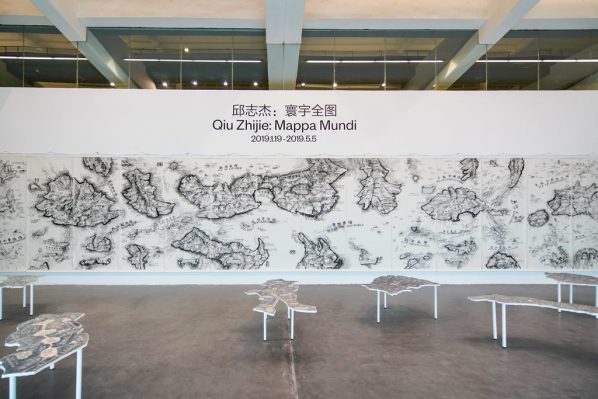
Maps, came into being before written characters, as one of the earliest tools for people to explore the world, they have enjoyed the most advanced technical support in the digital age, which has, however, in turn embarrassed their original definition—a click on a mobile digital map can gain access to abundant diverse information, much more solid than the map itself—the complex handicraft or expensive luxury and even the paper map still in use, they have lost all advantages over the changes of time.
However, artist Qiu Zhijie, a typical Scorpio workaholic, is still assiduously “drawing maps by hand”. There is one month left for Mappa Mundi, Qiu’s big solo exhibition in Ullens. The exhibition has been the most comprehensive and systematic presentation of his map series, which has been the focus of his creation for the last decade.
He is obsessed with maps. “I never get lost because I always have a map in my head.” 1 He suggests that everyone be a map drawer. In addition to hand-drawing, he also combines the popular artificial intelligence (AI) technology with the original map, another possible way out for the “map logic” in the era of intelligence.
Along his way, Qiu has received mixed reviews. Some have regarded him as an “encyclopedia” among artists, while others have called him a “strong and handsome athlete”. But he himself, just likes that his “map”, is alive, growing and replete with changes. Here, through the exhibition of Mappa Mundi, let’s have some fascinating insights into his art, and try to characterize the living artist with a list of several items.
I Omnivore:
“I was born in Fujian Province, China, in 1969. This determined that I’d be lucky to be an omnivore. I can eat whatever and escape from dying from it.” 2
Qiu Zhijie once described himself in this way.
II Multiple identities:
The “omnivore” has had traditional calligraphy training and learned seal cutting in his early years. In 1988 when he was studying printmaking in Zhejiang Academy of Art (the predecessor of China Academy of Art), Qiu studied philosophy and phenomenology under the influence of Fluxus and Boyce, and created installations, photography and new media. In 2003, he taught in the Department of Comprehensive Art of China Academy of Art. He took calligraphy and photography as a way for moral cultivation and held the position of curator, but never confined himself to being only an art medium—he conceived of a series of “grand plans”, such as the Railway from Lhasa to Katmandu (2006), The Project A Suicidology of the Nanjing Yangtze River Bridge (since 2007), etc. He, plays multiple roles including artist, theorist, educator, curator, and so on and is indeed an “omnivore”.
III Reconstruction of identity:
When asked the question “Who are you?” He, who has tried creation, writing, exhibition planning and teaching, he would have claimed himself as an “in-between” in the past; while now he considers himself a “Mapper”.
IV Debut of the Mapper:
Around 10 years ago, Qiu Zhijie was invited to draw a 20th Century Map for the “DLD—Digital Life Design”, a seminar held in Munich, which was not the first time he has been asked to do this. In the partial exhibition of the two works mentioned above, he demonstrated the relevance of the works in the whole exhibition hall and the logical position of the personal map which was shown: the ordered arrangement of complex information and the construction and processing of the subjective perspective.
V Amateur curators:
In 2011, Qiu was required to clearly describe who he was within 6 pages of the nomination album for the Hugo Boss Award. Maps, therefore, this helped him, as once again he had to condense his information within a certain number of pages. “It’s just a trick for ‘greedy’ people to pile infinite information within a limited space.” he admitted. 4 In the Shanghai Biennial in 2012, this rebellious man substituted the lengthy article that every curator should have written with Regeneration Map, mocking himself by saying that he has been a professional “amateur curator”.
Since then, the World Map Plan has gradually come into being.
VI A mapper would be shameful without a hundred maps:
Qiu Zhijie’s predestined relationship with maps seems to be providence. Since childhood, he has adored maps: as a middle school student, he could complete a jigsaw puzzle of 32 provinces of China in only 30 seconds in a competition; during his travel to Xinjiang, he drew ponds, pasture and villages on paper; and now as a curator, he completed the planning in a unique way by organizing the information through maps—over a hundred in total, 5 including 6 or 7 series, or “Qiu Zhijie Map on XXX”. It is mutual choice, mutual fulfillment—maps serve as a way for him to combine research, writing, imagination and active script; while he grants that maps are profound, artistic and have abundant meanings.
VII Broad knowledge out of rich experiences:
Mappa Mundi, grand and resounding, connects us with the poem The Imperial Capital City by Luo Bingwang, a famous poet in ancient China, which acclaims that the emperor, dukes, generals and ministers with “their fame will be world-known; their images will be painted in the painting cabinet and their glory will be as magnificent as the sun and moon”. The first glance of “mundi” will bring forth the image of the informative and knowledgeable “encyclopedia-like” Qiu Zhijie.
VIII Inheritance of Utopia:
The English version of the tittle corresponds little to its Chinese original— “Mappa mundi” is derived from the Latin term for a map of the world. “Mapping is one of the basic ways that western societies accept and understand the world. With maps, the unknown becomes visible and understandable. But they have also been used to scare potential visitors. In the primitive maps designed for Europeans, there was a clear mark of ‘Here be monsters’ in the location of the American Continent.” 6 As Charles Esche, curator of the 31st Sao Paulo Art Biennial in 2014 observed, “Qiu Zhijie constructs an unexpected narrative, a fictional city, or a strange utopian location, drawing on the history and techniques of map-making, combined with the tradition of ancient China for creating imaginary spaces.”
IX Ambition to conquer:
Maps are related to history. As material evidence, they visualize the rise and fall of a country, the formation of a religion, the birth of science and the process of change in the conquest of new territories. They also bring out the desire to explore the unknown and the ambition to conquer. It is always the case in both the East and the West. Examples are numerous: both the oldest extant Sumerian map created in the 27th century BC and the Babylonian map carved on clay tablets demonstrate the thinking and exploration of ancient peoples; the exquisite Ptolemaic map shows people's research and imagination; pieces of a wooden map of Qin Dynasty and paper map of Han dynasty unearthed from ancient Chinese tombs are also evidence of the trail; the advent of the age of the great voyages would challenge the authority of Ptolemy inherited from ancient Greece…The inheritance, structure and changing rules of maps remind us that every drawing is not only research but also a subversion, which is also a necessary requirement for artists—they should be equipped with the “ambition” of being thirsty and tireless.
X The extension of fantasy:
The story of map development was told in the large work Map of Maps (2016), which faced the exhibition hall. The title of the exhibition was also derived from the key elements within the work. Created for the Singapore Biennale, it was a collection of 16 panels that epitomized the artist’s research into the history of cartography. The combination of the Babylonian map, the medieval TO map, the adventurous history of such important geological events as Age of Exploration and Zheng He’s treasure voyages, as well as the evolution of the rules of cartography in different countries and regions such as China and Arabia reveals the close link between the map drawing and human fantasy, global politics, as well as historical development.
XI Reasonable intuition:
In their History of Cartography British cartographers Brian Harley and David Woodward define maps as “pictorial representations that give a spatial understanding of things, concepts, states, processes or the greatest events of the human world”. 8 Qiu Zhijie takes advantage of maps to establish the overall sense and sense of integrity of things, which provides a logical appreciation for the experience of organizational fragmentation; on the other hand, the maps he draws can also be regarded as a blueprint in his eyes. The design of the blueprint relies on intuition. “But good intuition should be reasonable,” he said. 9
XII Is there “Qiuzhijieism”?
Qiu Zhijie writes poems and plans exhibitions, and he is able to plan and construct poetry in the same space. His work Thoughts at the End of the World is arranged into islands with 28 tables, which are scattered in the space on the first floor of the new Urens Exhibition Hall. The table tops are covered by indigo rubbings, with each presenting a central topic, such as East Asian philosophy or realism. The suffix “-ism” in the dictionary covers almost everything; there are inappropriate examples, though, such as “the embracers of Tianfeiyuism” and “the embracers of Ullensism”. The only one thing, however, that “cannot be ‘-ismized’ is ‘-ism’ itself” [10]—this absurdity reveals the humor of Qiu’s style. From a proper angle different surprises can be acheived and therefore Qiu advises the audience to look down from the second floor—the form of the work is highlighted and becomes the element of poetic creation. People wander, pause, ponder and hover among the islands. But what haunts the artists is whether there is “Qiuzhijieism”?
XIII He who acts as a cook cannot tell stories so is not a fine artist:
Qiu Zhijie is a good story teller, but he tells stories in a different way. In the most important 24 maps of the exhibition Everything Series (2015-2017), he sketched all the maps from body, destiny, animal, plant, disease, architecture, story, mood map, Utopian map, occupation map to clothing. Each work can be a separate unit, and can also be connected together into a large circle. Elements of some stories can be linked, such as those in the plant map and the food map are interconnected; Dragon and Kylin in the animal map can be regarded as an important point in the deities map, etc. Were Qiu a cook, the preparing feast would be a giant dish combining the objective world of his cognition with his personal experience, which has all kinds of “color, aroma and taste”.
XIV Zooming eye in the art scene:
The giant wall painting Art Ecological Map is the ecological system of the art industry that has been developing since 1989, which is sorted out by Qiu. In it there are several different levels of art-related organizations, including artists, art institutions, an education system, an official system and so on. He said he was troubled by the fact that, as a veteran of the art world, some of its secrets could only be selectively drawn. “In maps I can zoom in, zoom out—and thus I’ll detail something but brief others; it’s good to leave some areas blank, isn’t it?” [11]
XV The “becoming aggressive and ambitious” Scorpio workaholic:
The exhibition displays both The Endless Picture created for the China pavilion of the 57th Venice Biennale and The Map of Contemporary Chinese Art created for the World Theatre Exhibition in the Guggenheim Museum.
Is this satisfactory for Qiu? Never. He constantly looks ahead.
The 2019 project Jingdong(JD) AI generated map (video of a live performance version) in the exhibition has attracted special attention. The front-end display of the map was made by a team from the Central Academy of Fine Arts based on hand-drawn maps by artist Qiu Zhijie, while the database core was completed by a team from the Research Institute of Artificial Intelligence of Jingdong Group.
XVI Warning⚠AI—a job snatcher:
“AI forces artists to rethink.” [12] Qiu Zhijie and Dr. He Xiaodong, who is in charge of artificial intelligence research at JD, keep on trying to broaden the possibilities of “maps” in artificial intelligence, which resembles an adventure in a new continent. This software installation introduces the high-frequency vocabulary of Qiu Zhijie’s map series and the JD word database containing tens of thousands of words, with which any valid input of words by the audience’s voice or typing will automatically generate a map with an artist’s creative style and the landscape and image elements in Qiu’s map.
XVII AI teaches people to create new art:
“AI may help us weed out some hidebound artists.” [13] Qiu makes use of AI software in art creation, just as ambitious as he was over a decade ago when he started to try cross-cutting new media. AI explorer Kai-fu Lee once mentioned in AI Superpowers (2018), “Based on the development of current technology and reasonable speculation, I think in 15-20 years, artificial intelligence and automation will have the technical ability to replace 40-50% of all jobs.” Such a prediction will come into reality mainly in repetitive labor, various interactions with fixed scripts and dialogue, simple data classification, such as customer service, sorting, assembly, etc. But it is true that some of the work cannot be completed by AI at present, especially the work that needs to propose new concepts or complex strategies, to offer empathy, and the like. Artists are such a combination of creativity and empathy, aren’t they?
XVIII Art has no set pattern:
The emergence of new technologies in each era has advanced human civilization, “Just as photography born in the late 19th century catalyzed the Impressionism, Van Gogh and Picasso.” [14] In regard of the two points we have mentioned above, those hidebound artists who do not think they are in danger. Once the art becomes a routine, the uncreative and conservative artists who have only formed patterns would be replaced by machines based on deep learning that can do the job quickly. From this perspective, it is high time that artists who have been repeating similar work take a closer look at reality.
XIX An ultimate question:
To Alan Turing’s question “Can machines really think?” there is, at present, no definite answer, and no one knows what the current broad and narrow sense of artificial intelligence technology can achieve. Instead, it touches on the fundamental question—whether “intelligence” can be realized—which has now triggered a heated discussion. What is certain, however, is that as a tool, AI’s deep collection of “data, data, data” can greatly help artists accomplish trivial tasks. Therefore, it is better to treat the machine as an assistant rather than an opponent.
XX Mind palace:
Qiu Zhijie, in the lecture “Generated Map and Map Generation” as part of the series of activities of the exhibition, unfolded an wildly imaginary scenario: in communication, people’s views and the map of the key words will appear on the virtual setting wall at the back of their heads, like a PPT, based on which the communication can be conducted. What he describes was exactly the same as the “mind palace” in the third series of Sherlock, in which the visualized memories are encoded in the mind to seemingly form a three-dimensional map. If this map were constructed, contradictions that arise from such a question as “How do I know what you're thinking?” would probably be greatly reduced. He hopes to find a way of communication to respond to groups of media who interview using the same questions over and over again.
XXI A professional player:
“Professionals like us don’t need to ‘find’ inspiration.” When it came to the topic of artist inspiration, Qiu Zhijie's straightforward talk caused a roar of laughter. “We received the work, and inspiration will come to us immediately”. [15]
XXII From here starts the interpretation of artist Qiu Zhijie's law. True or false, the artist is like a giant container, with more information than words can tell.
XXIII “My kind of weird is like a case of mental disorder of an era, and a case of the nation's mental illness over history. Throughout my relentless thirty years, I have, with insatiable desire, grown into a combination of both good and evil, earned my position in Heaven above and on earth below. Fierce involvement in history and the world makes it my destiny either to be covered with stones, or to be smelted into a Buddhist Sarira.
XXIV Fortunately, Qiu Zhijie will never be framed in items of the list.
(Exhibition site map & the work of Mappa Mundi are both provided by UCCA; pictures from his early years are taken from Qiu Zhijie's personal website; relevant pictures are taken from the Internet, please see the notes.)
Text (CN) by Zhang Yizhi, edited by Sue (EN)/CAFA ART INFO
Photo Courtesy of the Artist and UCCA.
Sources:
1 Everything Intelligent by Qiu Zhijie, Hunan Arts Printing Press, 2007 March, 1st Edition, p. 636, “World Map Plan”—Origin;
2[16] Why I Paint Ink and Wash Painting, from Qiu Zhijie’s personal website http://www.qiuzhijie.com/critiquelunwen/035.htm;
34 See 1, the same page;
5 Transcript from exhibition audio guide “What is the world map project”;
67 See 1, p. 732, The Nonexistent Traveler by Charles Escher, curator of 2014 Sao Paulo Art Biennial.
8 Introduction to 100 Maps that Changed the World by Li Wentian, Geography Teaching, Issue 17, 2015;
9 see 1, p. 637.
[10][11] Transcript from exhibition audio guide to Thoughts at the End of the World and Art Ecological Map;
[12][13][14][15] “Qiu Zhijie, He Xiaodong and Xie Zhouyi: Generated Map and Map Generation”, lecture as part of the series of activities of the exhibition (February 23rd, 2019, UCCA).


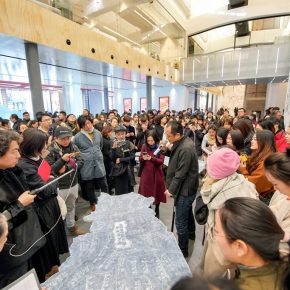
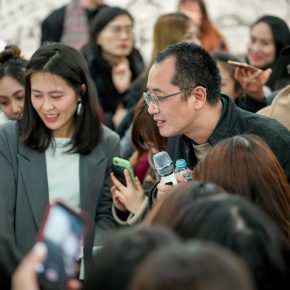
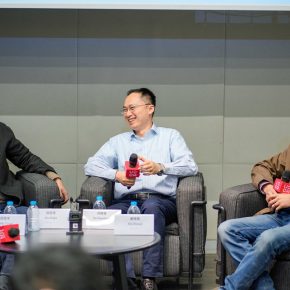
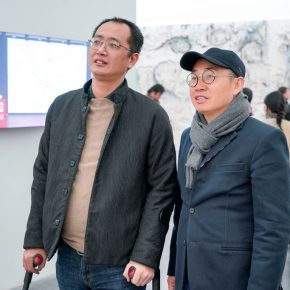
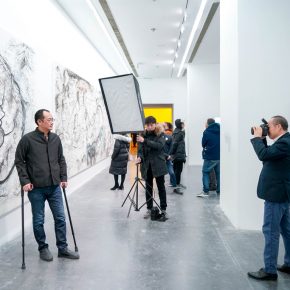
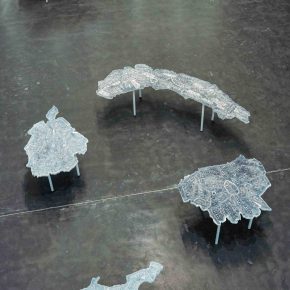



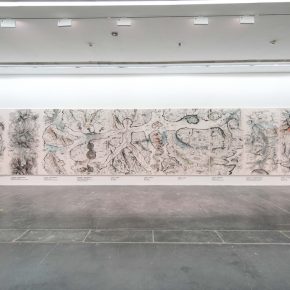
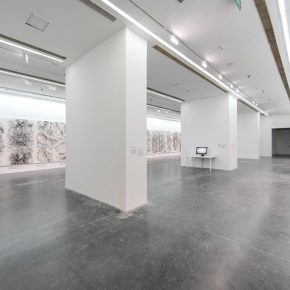
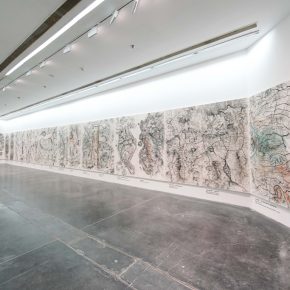
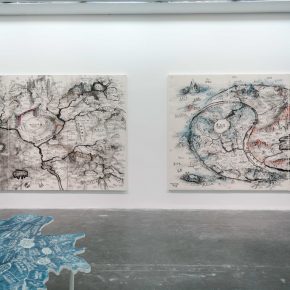
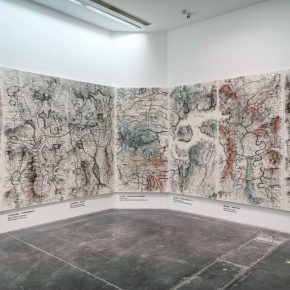
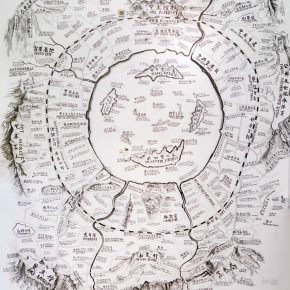
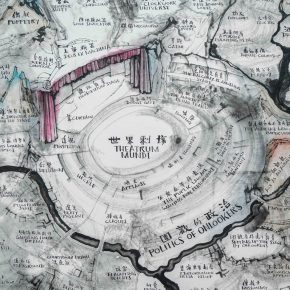
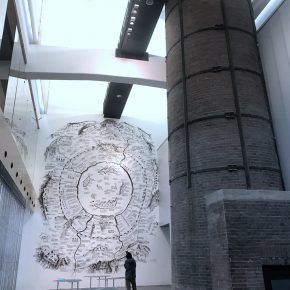
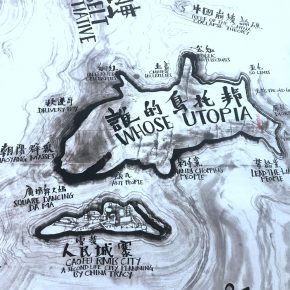
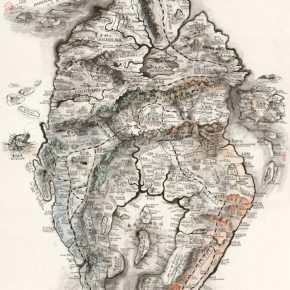
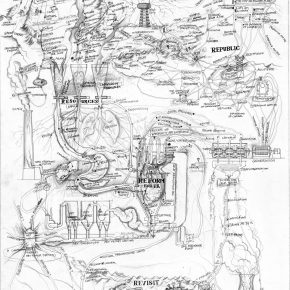
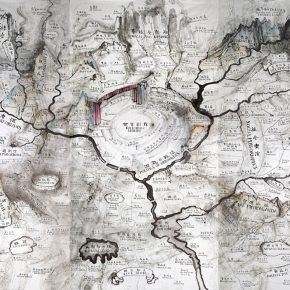

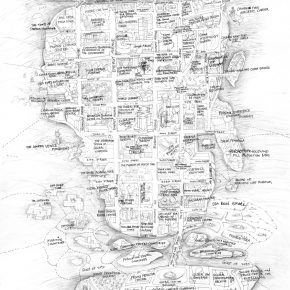
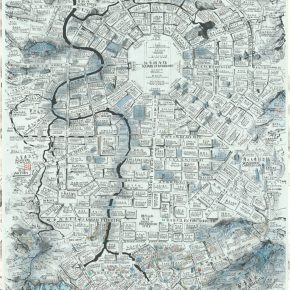


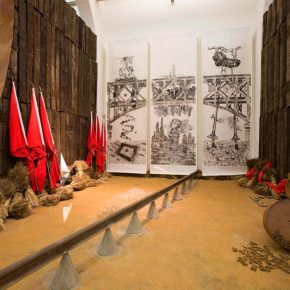


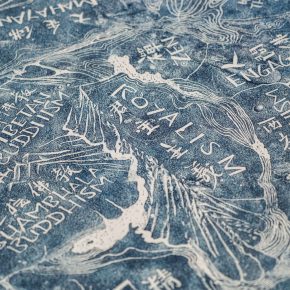
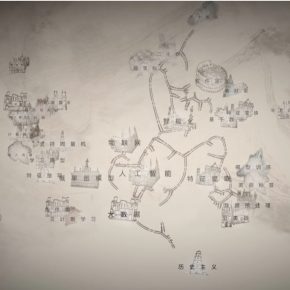
2010-290x290.jpg)


























